口译笔记讲课之 符号和例子
- 格式:ppt
- 大小:216.00 KB
- 文档页数:108
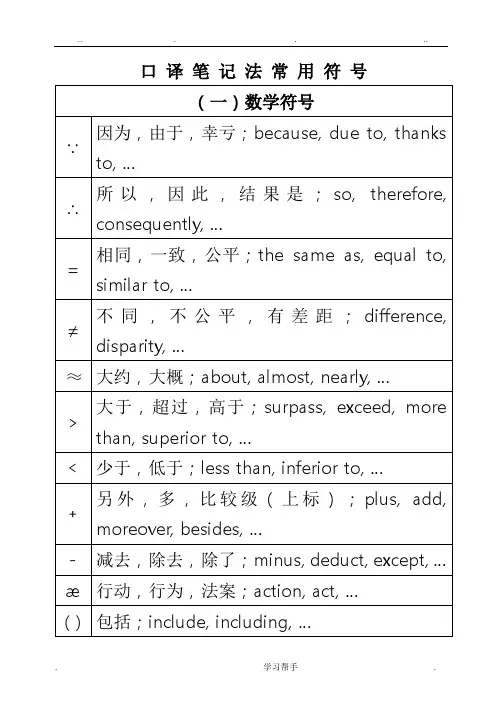
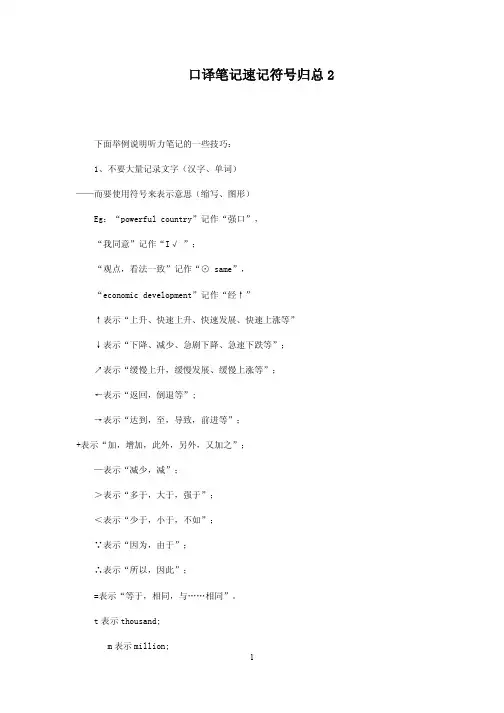
口译笔记速记符号归总2下面举例说明听力笔记的一些技巧:1、不要大量记录文字(汉字、单词)——而要使用符号来表示意思(缩写、图形)Eg:“powerful country”记作“强口”,“我同意”记作“I√ ”;“观点,看法一致”记作“⊙ same”,“economic development”记作“经↑”↑表示“上升、快速上升、快速发展、快速上涨等”↓表示“下降、减少、急剧下降、急速下跌等”;↗表示“缓慢上升,缓慢发展、缓慢上涨等”;←表示“返回,倒退等”;→表示“达到,至,导致,前进等”;+表示“加,增加,此外,另外,又加之”;—表示“减少,减”;>表示“多于,大于,强于”;<表示“少于,小于,不如”;∵表示“因为,由于”;∴表示“所以,因此”;=表示“等于,相同,与……相同”。
t表示thousand;m表示million;b表示 billion;1st表示first。
2、不要横着写:——而要竖着写,竖起来记有利于保持活意思意思以及数量等信息之间的逻辑界限。
3、逻辑关系要清楚明了——不要记流水帐。
以上是一些通行的的原则。
通行的原则存在,通行的方式却不存在,这是因为每个人的对记录符号的使用可能是多样的,同一事物不同的人可能会使用不同的符号,同一符号在不同的人意识中肯能代表不同的意思。
口译速记技巧口译考试之所以难,在于其长度和规定的限时。
估计很多参加过第二阶段口译考试的考生都有这样的经历,听的时候大意可以听懂,但是由于听时未作任何速记,关键词汇,逻辑关系在听后无法正确归纳,导致最后只能译出第一句或最后一句,而中间部分则完全忽略或遗忘。
真是如此,你是不可能通过口译考试的。
因此,自己在平日练习时一定要把速记归入计划之内。
总体上来说,速记符号主要有以下几类 :A。
保留大写字母或第一音节经济: E 教育: Edu 文化: C 政治: P 科技: ST 卫生: H旅游: T 环境: En 工业: I 农业: AB.简写缩略AFAC : as far as … is concerned( 就 …… 而言 )LFT : look forward to ( 期待 )ASAP : as soon as possible( 尽快 )C.图象⊕ 高兴,同意,满意等,如: happy , pleased , satisfied , agree…◎ 悲伤,生气,不满,不同意等,如:sad , angry , irritated , unsatisfied , sorrowful , discomfort , disagree… ⊙ 会议,如 conference , meeting , seminar , symposium…□ 国家,地区,如:中国:□ C ,俄国:□ RD.符号﹢高兴,男性,同意,增加等,如happy , male , agree , many , +2=more , +3=most , beneficial , good , beautiful , great , gorgeous…-悲伤,女性,不同意,减少等,如sad , female , disagree , little , few , -2=less , -3=least , lack of ,short of…√同意,正确等,如: agree , correct , right…×不同意,错误等,如: disagree , incorrect…↑增长,进步等,如: increase , soar , mushroom , rocket , make progress… ↓下降,退步,恶化等,如 decrease , sink , slide , subside , plump , plunge ,drop , degrade ,deteriorate…>多于,超过,比 …… 低一级等,如: more than , greater than , begger than ,better than , superior to , surpass , transcend , overtake…<少于,比 …… 低级等,如: less than , lower than , smaller than , inferior to…~大约,如: approximately , about , around , some , nearly , almost , similar to…/否定,清除,如: clear , settle , solve , tackle , conquer , eliminate ,extinct…≠与 …… 不同,如: differ from , different from , distinct , unique…$ 金钱,利益,如: interest , benefit , money , fund , capital…E.标点? 问题,麻烦,障碍,如: question , issue , difficult , hardship , barrier ,obstacle…: 主观想法和说辞,如: think , consider , speak , say , talk , mark , announce ,declare , hope ,例: repeat 或 reaffirm 可以用 :2 来替代,声明支持可以用 + :来替代,谴责用 - :。
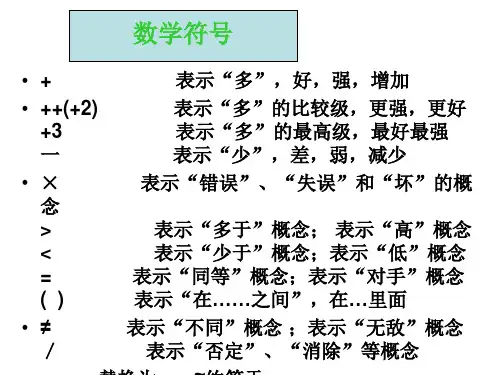
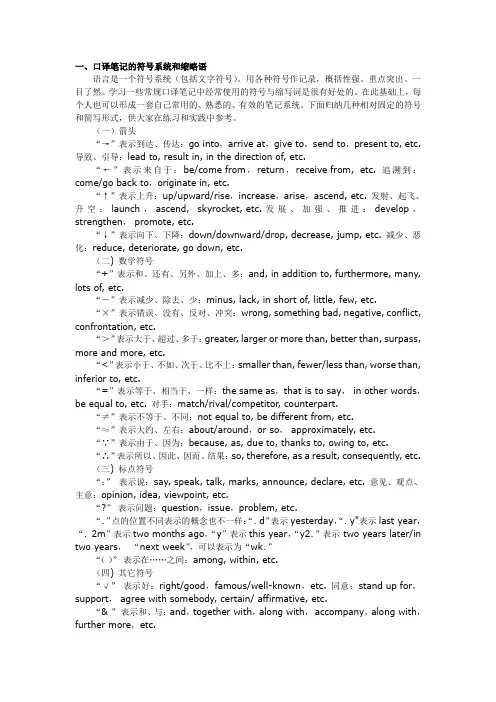
一、口译笔记的符号系统和缩略语语言是一个符号系统(包括文字符号)。
用各种符号作记录,概括性强、重点突出、一目了然。
学习一些常规口译笔记中经常使用的符号与缩写词是很有好处的。
在此基础上,每个人也可以形成一套自己常用的、熟悉的、有效的笔记系统。
下面归纳几种相对固定的符号和简写形式,供大家在练习和实践中参考。
(一)箭头“→”表示到达、传达:go into,arrive at,give to,send to,present to, etc. 导致、引导:lead to, result in, in the direction of, etc.“←”表示来自于:be/come from,return,receive from, etc. 追溯到:come/go back to,originate in, etc.“↑”表示上升:up/upward/rise,increase,arise,ascend, etc. 发射、起飞、升空:launch,ascend, skyrocket, etc.发展、加强、推进:develop,strengthen, promote, etc.“↓”表示向下、下降:down/downward/drop, decrease, jump, etc. 减少、恶化:reduce, deteriorate, go down, etc.(二) 数学符号“+”表示和、还有、另外、加上、多:and, in addition to, furthermore, many, lots of, etc.“-”表示减少、除去、少:minus, lack, in short of, little, few, etc.“×”表示错误、没有、反对、冲突:wrong, something bad, negative, conflict, confrontation, etc.“>”表示大于、超过、多于:greater, larger or more than, better than, surpass, more and more, etc.“<”表示小于、不如、次于、比不上:smaller than, fewer/less than, worse than, inferior to, etc.“=”表示等于、相当于、一样:the same as,that is to say, in other words,be equal to, etc. 对手:match/rival/competitor, counterpart.“≠”表示不等于、不同:not equal to, be different from, etc.“≈”表示大约、左右:about/around,or so, approximately, etc.“∵”表示由于、因为:because, as, due to, thanks to, owing to, etc.“∴”表示所以、因此、因而、结果:so, therefore, as a result, consequently, etc.(三) 标点符号“:”表示说:say, speak, talk, marks, announce, declare, etc. 意见、观点、主意:opinion, idea, viewpoint, etc.“?”表示问题:question,issue,problem, etc.“.”点的位置不同表示的概念也不一样:“.d”表示yesterday,“.y"表示last year,“.2m”表示two months ago,“y”表示this year,“y2.”表示 two years later/in two years,“next week”,可以表示为“wk.”“()”表示在……之间:among, within, etc.(四) 其它符号“√”表示好:right/good,famous/well-known,etc. 同意:stand up for,support, agree with somebody, certain/ affirmative, etc.“& ”表示和、与:and,together with,along with, accompany,along with,further more,etc.“☆”表示重要的、杰出的、优秀的、榜样:important, best,outstanding,brilliant,model, etc.“∥”表示结束:end,stop,halt,bring something to a standstill/stop, etc.“°”表示人、者:person, people, 如经济学家可以表示为“经°”,中国人可以表示为“中°”,etc.“⊙”表示会议、讨论、谈判:meeting, seminar, discussion, negotiation, etc.“♂”表示男人:man, male, boy, etc.“♀”表示女人:woman, female, girl, etc.“□”表示国家:country, state, nation, etc.“△”表示代表:represent, on behalf of, etc.“∽”表示交流、交换、替代、相互:exchange, mutual, each other, communication, replace, etc.(五) 缩略词英语缩写词的写法一般有以下几种:●拿掉所有元音。
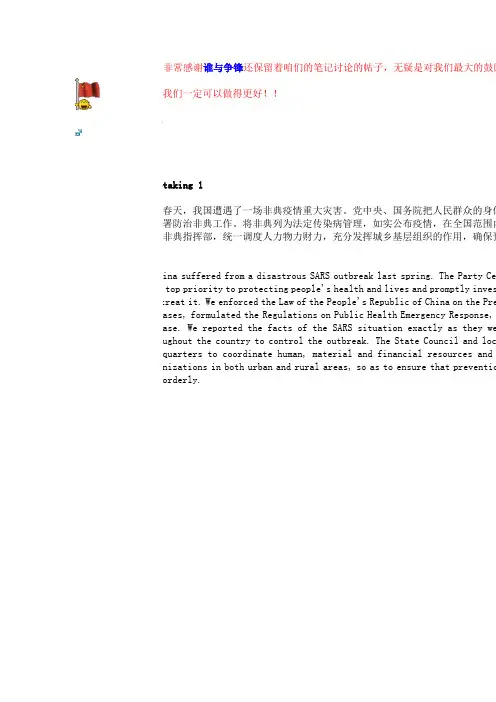
非常感谢谁与争锋还保留着咱们的笔记讨论的帖子,无疑是对我们最大的鼓励相信我们一定可以做得更好!!ricotetaking 1去年春天,我国遭遇了一场非典疫情重大灾害。
党中央、国务院把人民群众的身体和部署防治非典工作。
将非典列为法定传染病管理,如实公布疫情,在全国范围内防治非典指挥部,统一调度人力物力财力,充分发挥城乡基层组织的作用,确保预.China suffered from a disastrous SARS outbreak last spring. The Party Ce ave top priority to protecting people's health and lives and promptly inves nd treat it. We enforced the Law of the People's Republic of China on the Pre iseases, formulated the Regulations on Public Health Emergency Response, isease. We reported the facts of the SARS situation exactly as they we hroughout the country to control the outbreak. The State Council and loc eadquarters to coordinate human, material and financial resources and rganizations in both urban and rural areas, so as to ensure that preventio nd orderly.分析:要说明的一点是这个版本完全是我自己的版本,最终出来的结果也绝对和英文版的不一样。
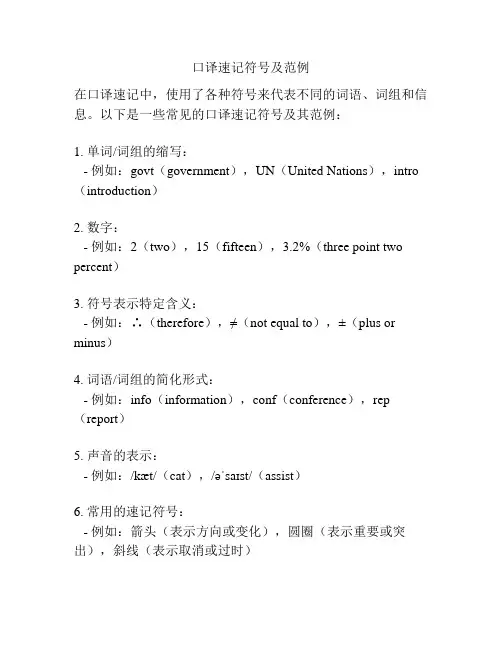
口译速记符号及范例
在口译速记中,使用了各种符号来代表不同的词语、词组和信息。
以下是一些常见的口译速记符号及其范例:
1. 单词/词组的缩写:
- 例如:govt(government),UN(United Nations),intro (introduction)
2. 数字:
- 例如:2(two),15(fifteen),3.2%(three point two percent)
3. 符号表示特定含义:
- 例如:∴(therefore),≠(not equal to),±(plus or minus)
4. 词语/词组的简化形式:
- 例如:info(information),conf(conference),rep (report)
5. 声音的表示:
- 例如:/kæt/(cat),/əˈsaɪst/(assist)
6. 常用的速记符号:
- 例如:箭头(表示方向或变化),圆圈(表示重要或突出),斜线(表示取消或过时)
7. 符号的组合和结构:
- 例如:↑(上升),↓(下降),→(发展),←(反对)
8. 表示固定短语或俚语的符号:
- 例如:BFF(best friends forever),TGIF(Thank God it's Friday)
请注意,以上仅为一些常见的例子,实际上口译速记符号有很多种,各口译员可能会根据个人习惯和需求进行一些定制或修改。
使用哪些符号以及如何使用符号,都取决于个人风格和技巧。
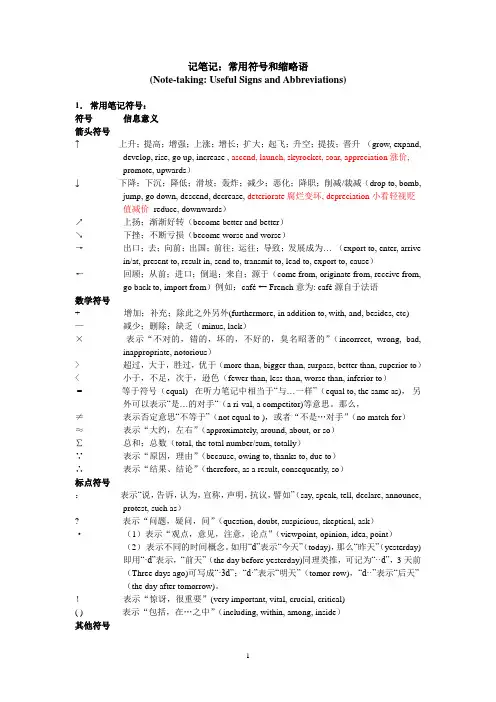
记笔记:常用符号和缩略语(Note-taking: Useful Signs and Abbreviations)1.常用笔记符号:符号信息意义箭头符号↑上升;提高;增强;上涨;增长;扩大;起飞;升空;提拔;晋升(grow, expand, develop, rise, go up, increase , ascend, launch, skyrocket, soar, appreciation涨价,promote, upwards)↓ 下降;下沉;降低;滑坡;轰炸;减少;恶化;降职;削减/裁减(drop to, bomb, jump, go down, descend, decrease, deteriorate腐烂变坏, depreciation小看轻视贬值减价reduce, downwards)↗上扬;渐渐好转(become better and better)↘下挫;不断亏损(become worse and worse)→出口;去;向前;出国;前往;运往;导致;发展成为…(export to, enter, arrive in/at, present to, result in, send to, transmit to, lead to, export to, cause)←回顾;从前;进口;倒退;来自;源于(come from, originate from, receive from, go back to, import from)例如:café← French意为: café源自于法语数学符号+ 增加;补充;除此之外另外(furthermore, in addition to, with, and, besides, etc) —减少;删除;缺乏(minus, lack)×表示“不对的,错的,坏的,不好的,臭名昭著的”(incorrect, wrong, bad, inappropriate, notorious)> 超过,大于,胜过,优于(more than, bigger than, surpass, better than, superior to)< 小于,不足,次于,逊色(fewer than, less than, worse than, inferior to)= 等于符号(equal) 在听力笔记中相当于“与…一样”(equal to, the same as),另外可以表示“是…的对手“(a ri-val, a competitor)等意思。
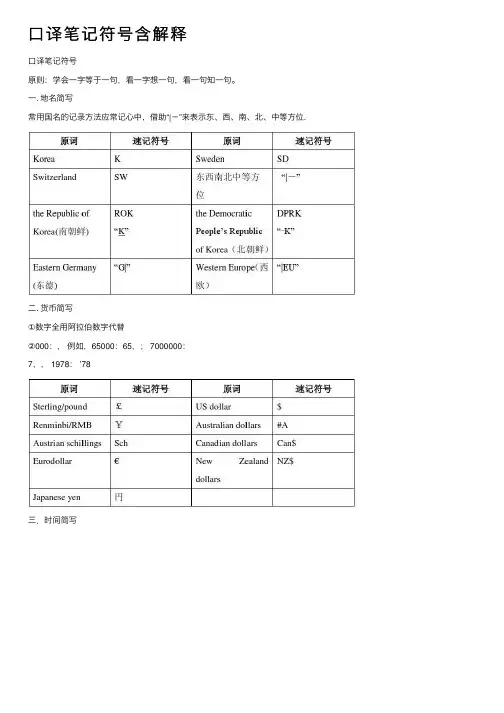
⼝译笔记符号含解释⼝译笔记符号原则:学会⼀字等于⼀句,看⼀字想⼀句,看⼀句知⼀句。
⼀. 地名简写常⽤国名的记录⽅法应常记⼼中,借助“|-”来表⽰东、西、南、北、中等⽅位.⼆. 货币简写①数字全⽤阿拉伯数字代替②000:,例如,65000:65,; 7000000:7,, 1978: ’78三.时间简写四.度量衡五. 缩略词缩略词的写法⼀般为四种⽅式:拿掉所有元⾳、保留前⼏个字母、保留开头和结尾个发⾳字母、根据发⾳六.较长单词的处理办法-ism 简写为m例如:socialism Sm-tion 简写为n例如:standardization (标准化) stdn -cian 简写为o 例如:technician techo-ing 简写为g 例如:marketing (市场营销) MKTg-ed 简写为 d 例如:accepted acptd-ment 简写为mt 例如:amendment amdmt-able/ible/ble 简写为bl 例如:available avbl-ful 简写为fl 例如:meaningful mnfl七.字母、图像、符号o表⽰“⼈”people/person,因为“o”看上去像个⼈头,它通常被写在⼀个词或符号的右上⾓。
例如:⽇本⼈:Jo。
C 表⽰政府,统治:government,govern。
希腊字母C读/ga:ma/,近似government, 所以就⽤C来表⽰govern, government。
governmental official 可以表⽰为CZ。
P 表⽰政治:politics, political希腊字母P读/pai/,近似politics, political。
那么politician就可以表⽰为PZ。
G 表⽰效率:efficient, effective。
G为效率符号。
Q 表⽰“通货膨胀”:inflation 因为这个符号酷似⼀个上升的⽓球。
A 表⽰农业: agriculture. agriculture经常⽤到,所以⽤⾸字母代替。
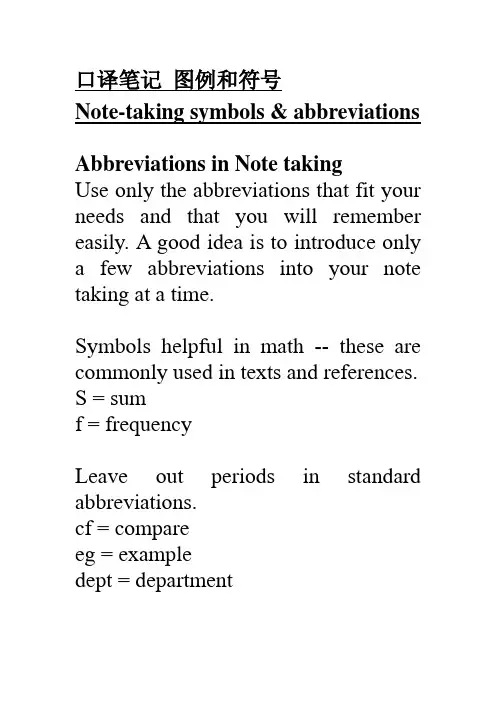
口译笔记图例和符号Note-taking symbols & abbreviations Abbreviations in Note takingUse only the abbreviations that fit your needs and that you will remember easily. A good idea is to introduce only a few abbreviations into your note taking at a time.Symbols helpful in math -- these are commonly used in texts and references. S = sumf = frequencyLeave out periods in standard abbreviations.cf = compareeg = exampledept = departmentUse only the first syllable of a word. pol = politicsdem = democracylib = liberalcap = capitalismUse entire first syllable and only 1st letter of 2nd syllable.pres = presentationsubj = subjectind = individualcons = conservativeEliminate final letters. Use just enough of the word to form a recognizable abbreviation.assoc = associatebio. = biologyinfo = informationach = achievementchem = chemistrymax = maximumintro = introductionconc = concentrationmin = minimumrep = repetitionOmit vowels, retain only enough consonants to give a recognizable skeleton of the word.ppd = preparedprblm = problemestmt = estimatebkgd = backgroundgvt = governmentUse an apostrophe in place of letters. am’t = amountcont’d = continuedgov’t = governmenteducat’l = educationalForm the plural of a symbol or abbreviated word by adding s.chpts = chaptersegs = examplesfs = frequenciesintros = introductionsUse g to represent ing endings.ckg = checkingestg = establishingdecrg = decreasingexptg = experimentingIf a term, phrase, or name is written out in full during the lecture, substitute initials whenever the term, phrase, or name is used again.CAS = Center for Aerospace Sciences Use symbols for commonly recurring connective or transitional words.& = andw = withw/o = withoutvs = against\ = therefore= = is / equalUse technical symbols where applicable.ibid = Latin, the same worko = degreesH2O = waterUse standard maths, accounting, and science symbols.+ plus// parallelUse standard abbreviations and leave out full stops.eg exampleIT Information TechnologyUK United KingdomUse only the first syllable of a word.Mar=marketingCus= customerCli=clientUse the entire first syllable and the first letter of the second syllable. Subj= subjectBudg= budgetInd= individualTo distinguish among various forms of the same word, use the first syllable of the word, an apostrophe, and the ending of the word.tech'gy=technologygen'ion=generalisationdel'y=deliveryUse just enough of the beginning of a word to form a recognisable abbreviation.Assoc= associatedAch= achievementInfo=informationOmit vowels from the middle of words, retaining only enough consonants to provide a recognisable skeleton of the word.Bkgd=backgroundMvmt=movementPrblm= problemForm the plural of a symbol or abbreviated word by adding 's.' Custs= customersFs= frequenciesUse 'g' to represent 'ing' endings. Decrg= decreasingCkg= checkingEstblg= establishingLeave out unnecessary articles.a an theIf a term, phrase, or name is initially written out in full during the talk or meeting, initials can be substituted whenever the term, phrase, or name is used again.JACB= January Advertising Campaign BudgetUse symbols for common connective or transition words.@ =at 2=to4=for &=andvs= againstCreate your own set of abbreviations and symbols. You may wish to develop separate sets of symbols and abbreviations for different courses or subjects.Other Symbols and Abbreviations<---> as a result of / consequences of ---> resulting in+ and / also= equal to / same asff following* most importantly< less than> greater thanEsp. especially字母、图像人people/person,日本人:日人P 政治,politics, politicalE 总数,total, totally, entire, entirely, on the whole, all in all, to sum up, etc. G效率:efficient, effectiveQ“通货膨胀”:inflationA农业: agriculture. agricultureB商业:businessC×冲突,矛盾conflict,confrontation W工作,职业: work, employi工业: industry, industrialU U 看酷似一个酒杯,在笔记中表示合同、协议(treaty, agreement)一般只有在谈判成功、协议成交后才会表示“举杯祝贺”。
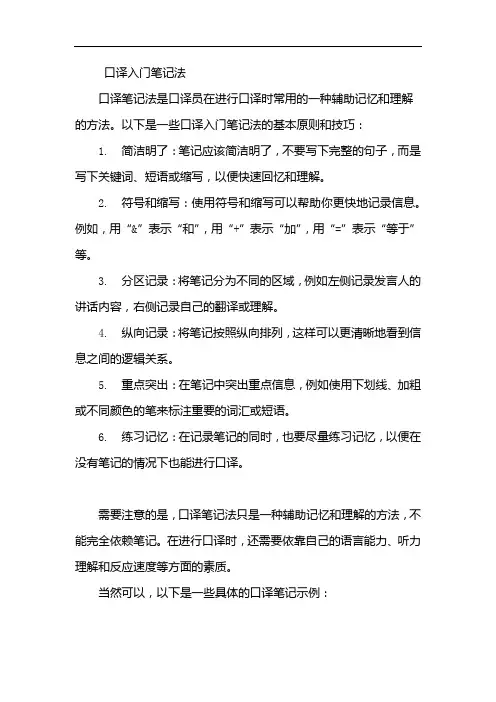
口译入门笔记法口译笔记法是口译员在进行口译时常用的一种辅助记忆和理解的方法。
以下是一些口译入门笔记法的基本原则和技巧:1. 简洁明了:笔记应该简洁明了,不要写下完整的句子,而是写下关键词、短语或缩写,以便快速回忆和理解。
2. 符号和缩写:使用符号和缩写可以帮助你更快地记录信息。
例如,用“&”表示“和”,用“+”表示“加”,用“=”表示“等于”等。
3. 分区记录:将笔记分为不同的区域,例如左侧记录发言人的讲话内容,右侧记录自己的翻译或理解。
4. 纵向记录:将笔记按照纵向排列,这样可以更清晰地看到信息之间的逻辑关系。
5. 重点突出:在笔记中突出重点信息,例如使用下划线、加粗或不同颜色的笔来标注重要的词汇或短语。
6. 练习记忆:在记录笔记的同时,也要尽量练习记忆,以便在没有笔记的情况下也能进行口译。
需要注意的是,口译笔记法只是一种辅助记忆和理解的方法,不能完全依赖笔记。
在进行口译时,还需要依靠自己的语言能力、听力理解和反应速度等方面的素质。
当然可以,以下是一些具体的口译笔记示例:1. 符号和缩写:- 使用符号“/”表示“或者”,例如“China/US”表示“中国或美国”。
- 使用缩写“WTO”表示“世界贸易组织”,“GDP”表示“国内生产总值”。
2. 分区记录:- 将笔记分为左右两个区域,左侧记录发言人的讲话内容,右侧记录自己的翻译或理解。
- 在左侧区域中,可以使用纵向排列的方式记录信息,例如“经济发展/环境保护”。
- 在右侧区域中,可以写下自己的翻译“Economic development/Environmental protection”。
3. 重点突出:- 使用下划线、加粗或不同颜色的笔来标注重要的词汇或短语,例如“全球化”、“可持续发展”等。
- 可以使用箭头或其他符号来表示信息之间的逻辑关系,例如“因为-所以”、“虽然-但是”等。
需要注意的是,口译笔记法是一种辅助记忆和理解的方法,不能完全依赖笔记。
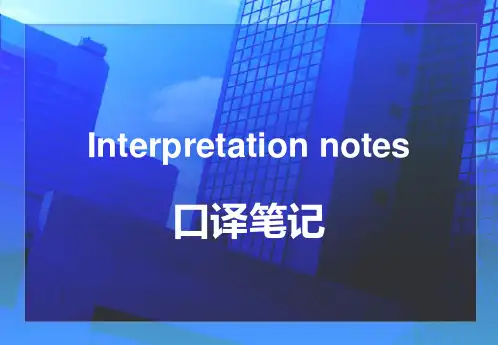
口译速记符号及范例
在口译过程中,速记是一种非常重要的技能,可以帮助译员更快速、准确地记录和传达信息。
以下是一些常用的口译速记符号及范例,供译员参考。
1.缩写符号
缩写符号是指将一个词或短语的首字母缩写成一个速记符号。
例如:
UN(联合国)
OPEC(石油输出国组织)
VIP(要人)
2.数字速记符号
数字速记符号可以用来表示数量、时间、日期等。
例如:
2000—至今:表示从2000年到现在。
|:用一条线表示一个时间段或过程。
例如:“from 2000—to date”表示从2000年到现在。
1,2,3,…):或递减(10,9,8,…)。
例如:第一名、最后一名等。
3.比较关系速记符号
使用大于(>)和小于(<)符号来表示比较关系。
例如:
5(>5):表示大于5。
小于3(<3):表示小于3。
4.加减运算速记符号
在进行加减运算时使用加号(+)和减号(-)。
例如:
5+3=8(5加3等于8)。
5.百分比速记符号
在表示百分比时使用百分号(%)。
例如:
50%(百分之五十):表示50/100。
6.特殊符号及用法。
纯干货—英语口译笔记符号!整理/涟漪花了几天整理的英语口译笔记符号,在简书编辑的时候,发现我在Word里面画的图形都不能复制过来,那可以是我花了大量时间做好的,就只能留着自己用啦,哈哈哈......以下为非图形部分,希望对想学英语口译的朋友们有所帮助。
我也是才开始学习,能分享的不多,大家加油。
(一)、数学符号∵:because, due to, thanks to…∴:so, therefore, consequently…=:the same as, equal to, agree…≠:difference, disparity, dispute, disagreement, divergence…≈:about, almost, nearly, similar…>:surpass, exceed, more than, superior to…<:less than, inferior to…+:plus, moreover, b esides, add, more…-:minus, deduct, except…:action, act, implement, carry out, conduct, execute, finish,complete, fulfill…[ ]:among, within…∈:belong to…×:① mistake, wrong, bad, notorious ② no, refuse, decline, rebuff…√:① correct, affirmative, precise,accurate, right ② done…(二)、常用符号::think, hear, look, say, see, express…:problem, question, problem, issue, ask, puzzle, query, confused, mystery, bewildered…!:watch out, dangerous, warning, heed, alarming, alert, hazardous, perilous, jeopardy...:mess age, information, intelligence…~:trade, exchange, communication, relationship…_:underline, emphasize, highlight, pay attention to…e.g.:for example, such as, for instance…)(:confrontation, conflict, faced with…$:dollar, currency, cash, coin, income, salary, wage, money, rich,well-off, expensive, cost…¥:value, benefit, worthy…4:accident, event,incident…#:only, just...×#:not only...→:go, come, arrive…(三)、偏旁或部首文:①school, college, university ②culture, civilization…:study, learn...。
一、口译笔记的符号系统和缩略语语言是一个符号系统(包括文字符号)。
用各种符号作记录,概括性强、重点突出、一目了然。
学习一些常规口译笔记中经常使用的符号与缩写词是很有好处的。
在此基础上,每个人也可以形成一套自己常用的、熟悉的、有效的笔记系统。
下面归纳几种相对固定的符号和简写形式,供大家在练习和实践中参考。
(一)箭头“→”表示到达、传达:go into,arrive at,give to,send to,present to, etc. 导致、引导:lead to, result in, in the direction of, etc.“←”表示来自于:be/come from,return,receive from, etc. 追溯到:come/go back to,originate in, etc.“↑”表示上升:up/upward/rise,increase,arise,ascend, etc. 发射、起飞、升空:launch,ascend, skyrocket, etc.发展、加强、推进:develop,strengthen,promote, etc.“↓”表示向下、下降:down/downward/drop, decrease, jump, etc. 减少、恶化:reduce, deteriorate, go down, etc.(二) 数学符号“+”表示和、还有、另外、加上、多:and, in addition to, furthermore, many, lots of, etc.“-”表示减少、除去、少:minus, lack, in short of, little, few, etc.“×”表示错误、没有、反对、冲突:wrong, something bad, negative, conflict, confrontation, etc.“>”表示大于、超过、多于:greater, larger or more than, better than, surpass, more and more, etc.“<”表示小于、不如、次于、比不上:smaller than, fewer/less than, worse than, inferior to, etc.“=”表示等于、相当于、一样:the same as,that is to say,in other words,be equal to, etc. 对手:match/rival/competitor, counterpart.“≠”表示不等于、不同:not equal to, be different from, etc.“≈”表示大约、左右:about/around,or so,approximately, etc.“∵”表示由于、因为:because, as, due to, thanks to, owing to, etc.“∴”表示所以、因此、因而、结果:so, therefore, as a result, consequently, etc.(三) 标点符号“:” 表示说:say, speak, talk, marks, announce, declare, etc. 意见、观点、主意:opinion, idea, viewpoint, etc.“?” 表示问题:question,issue,problem, etc.“.”点的位置不同表示的概念也不一样:“.d”表示yesterday,“.y"表示last year,“.2m”表示two months ago,“y”表示this year,“y2.”表示two years later/in two years,“next week”,可以表示为“wk.”“()” 表示在……之间:among, within, etc.(四) 其它符号“√” 表示好:right/good,famous/well-known,etc. 同意:stand up for,support,agree with somebody, certain/ affirmative, etc.“& ” 表示和、与:and,together with,along with,accompany,along with,further more,etc.“☆” 表示重要的、杰出的、优秀的、榜样:important,best,outstanding,brilliant,model, etc.“∥” 表示结束:end,stop,halt,bring something to a standstill/stop, etc.“°”表示人、者:person, people, 如经济学家可以表示为“经°”,中国人可以表示为“中°”,etc.“⊙”表示会议、讨论、谈判:meeting, seminar, discussion, negotiation, etc.“♂”表示男人:man, male, boy, etc.“♀”表示女人:woman, female, girl, etc.“□”表示国家:country, state, nation, etc.“△”表示代表:represent, on behalf of, etc.“∽”表示交流、交换、替代、相互:exchange, mutual, each other, communication, replace, etc.(五) 缩略词英语缩写词的写法一般有以下几种:∙拿掉所有元音。
常见笔译符号!惊叹,奇迹# 停止,暂停 & 与,和,共同∈属于 ←来自于∞ 与…的关系 ↑增长,增加∽被替换为 →导致,结果是⊕医院 ↓下降,减少,降低⊙会议 ↗渐增☆杰出的,出众的 ↘渐降≈大约为,差不多 ∴所以< 小于,弱于 ∵因为➢大于,强于 ♀男的〈〈远小于,远弱于 ♂女的〉〉远大于,远强于 О人;pº政治家;Ecoº经济学家┷在压力下 H 主持;hº主持人*重要的,优秀的 $ 富有,$º富人∑总和 + 加上,除此之外商标 -减去,除去:说,发表,观点是 问题,疑惑,难题@ 关于 ×错误,不好,否定© 版权,知识产权 √ 正确,好□国家6. 笔记示范: (1)“美国、英国、德国、日本、瑞士和法国的中央银行想扭转这种不良趋势,但都没有成功,而且还损失了几十亿美元。
一年多以后,美元才恢复到原先对日元的偏低比价。
1981年,法国法郎也经受过相似的经历,密特朗总统被迫因此调整了他的经济政策。
” Am Uk Ger 央行 Jap attpt 变×trend Swis Fran but All × & ×bs $ 1> yr $原R低/ 日 1981 法F ≈ × ∴法Pr have to adj Eco. P (2)“我认真听取了其他国家在这个议题下的发言。
各国对信息和通信技术促进发展的重要性有着共同的认识,在信息和通信技术促进发展方面都取得了不同程度的进步。
我为此感到鼓舞。
中国是一个发展中的大国,我们对于信息和通信技术促进发展的重要意义有着切身的感受。
” 听□s: 共识:※/imf + comu → devp 发展 ∴I,! Chi, 大devping 切feel: (3)“现在,世界多极化和经济全球化趋势深入发展,经济进步日新月异,综合国力竞争日趋激烈,国际局势正在发生深刻的变化。